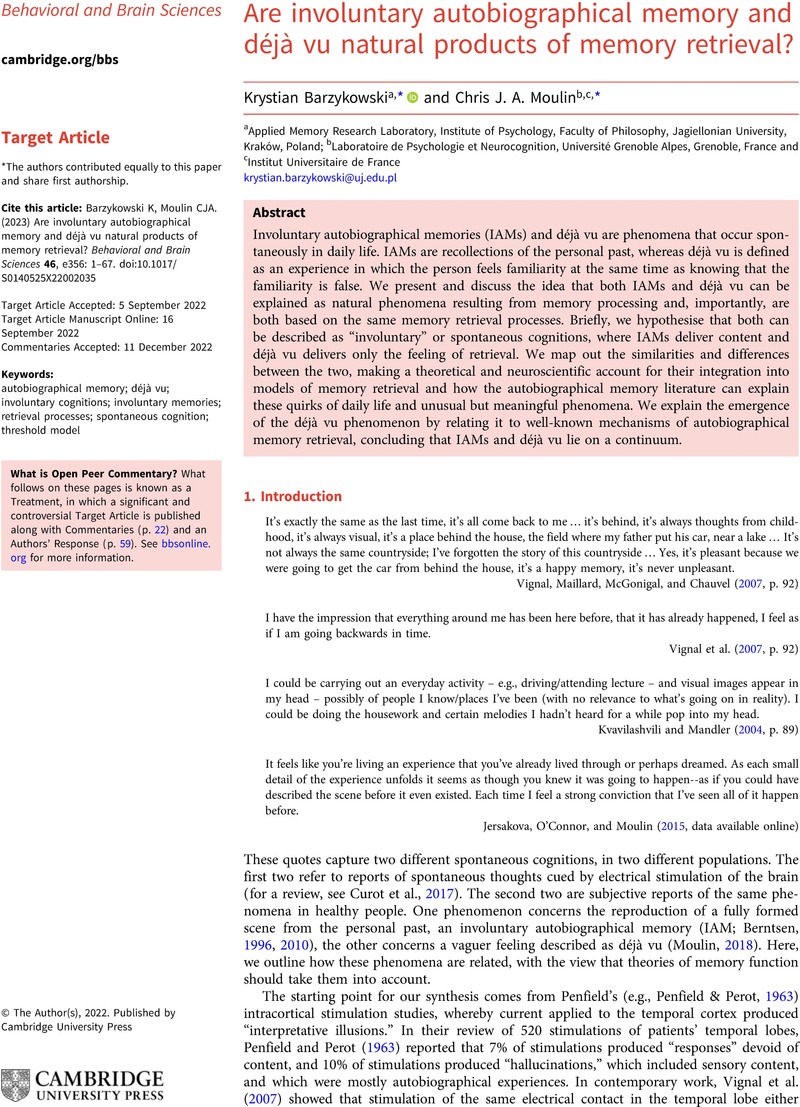No CrossRef data available.
Article contents
Déjà vu may be illusory gist identification
Published online by Cambridge University Press: 14 November 2023
Abstract
An abstract is not available for this content so a preview has been provided. Please use the Get access link above for information on how to access this content.

Information
- Type
- Open Peer Commentary
- Information
- Copyright
- Copyright © The Author(s), 2023. Published by Cambridge University Press
References
Brady, T., & Alvarez, G. (2011). Hierarchical encoding in visual working memory: Ensemble statistics bias memory for individual items. Psychological Science, 22, 384–392.CrossRefGoogle ScholarPubMed
Chong, S. C., & Treisman, A. (2003). Representation of statistical properties. Vision Research, 43, 393–404.CrossRefGoogle ScholarPubMed
Cleary, A. M. (2008). Recognition memory, familiarity, and déjà vu experiences. Current Directions in Psychological Science, 17(5), 353–357.CrossRefGoogle Scholar
Cohen, M. A., Dennett, D., & Kanwisher, N. (2016). What is the bandwidth of perceptual experience? Trends in Cognitive Sciences, 20, 324–335.CrossRefGoogle ScholarPubMed
Emmanouil, T., & Treisman, A. (2008). Dividing attention across feature dimensions in statistical processing of perceptual groups. Perception and Psychophysics, 70, 946–954.CrossRefGoogle ScholarPubMed
Haberman, J., Lee, P., & Whitney, D. (2015). Mixed emotions: Sensitivity to facial variance in a crowd of faces. Journal of Vision, 15(4), 1–11.CrossRefGoogle Scholar
Haberman, J., & Whitney, D. (2009). Seeing the mean: Ensemble coding for sets of faces. Journal of Experimental Psychology: Human Perception and Performance, 35, 718–734.Google ScholarPubMed
Lew, T., & Vul, E. (2015). Ensemble clustering in visual working memory biases location memories and reduces the Weber noise of relative positions. Journal of Vision, 15(4), 10.CrossRefGoogle ScholarPubMed
McClelland, T., & Bayne, T. (2016). Ensemble coding and two conceptions of perceptual sparsity. Trends in Cognitive Sciences, 20, 641–642.CrossRefGoogle ScholarPubMed
Sweeny, T., Haroz, S., & Whitney, D. (2013). Perceiving group behavior: Sensitive ensemble coding mechanisms for biological motion of human crowds. Journal of Experimental Psychology: Human Perception and Performance, 39, 329–337.Google ScholarPubMed
Sweeny, T., & Whitney, D. (2014). Perceiving crowd attention: Ensemble perception of a crowd's gaze. Psychological Science, 25, 1903–1913.CrossRefGoogle ScholarPubMed
Whitney, D., & Leib, A. (2018). Ensemble perception. Annual Review of Psychology, 69, 12.1–12.25.CrossRefGoogle ScholarPubMed
Yonelinas, A. P. (2002). The nature of recollection and familiarity: A review of 30 years of research. Journal of Memory and Language, 46, 441–517.CrossRefGoogle Scholar



Target article
Are involuntary autobiographical memory and déjà vu natural products of memory retrieval?
Related commentaries (27)
A possible shared underlying mechanism among involuntary autobiographical memory and déjà vu
A rational analysis and computational modeling perspective on IAM and déjà vu
A spontaneous neural replay account for involuntary autobiographical memories and déjà vu experiences
Accommodating the continuum hypothesis with the déjà vu/déjà vécu distinction
Accounting for the strangeness, infrequency, and suddenness of déjà vu
Are involuntary autobiographical memory and déjà vu cognitive failures?
Cueing involuntary memory
Deconstructing spontaneous expressions of memory in dementia
Distinguishing involuntary autobiographical memories and déjà vu experiences: Different types of cues and memory representations?
Does inhibitory (dys)function account for involuntary autobiographical memory and déjà vu experience?
Déjà vu and involuntary autobiographical memories as two distinct cases of familiarity in patients with Alzheimer's disease
Déjà vu may be illusory gist identification
Déjà vu: A botched memory operation, illegitimate to start with
Evolutionary mismatch and anomalies in the memory system
From jamais to déjà vu: The respective roles of semantic and episodic memory in novelty monitoring and involuntary memory retrieval
Intracranial electrical brain stimulation as an approach to studying the (dis)continuum of memory experiential phenomena
Involuntary autobiographical memories and déjà vu: When and why attention makes a difference
Involuntary memories are not déjà vu
Involuntary memory signals in the medial temporal lobe
Neuropsychological predictions on involuntary autobiographical memory and déjà vu
Oh it's me again: Déjà vu, the brain, and self-awareness
On pattern completion, cues and future-oriented cognition
On the frequency and nature of the cues that elicit déjà vu and involuntary autobiographical memories
The misidentification syndromes and source memory deficits with their neuroanatomical correlates from neuropsychological perspective
The need for a unified framework: How Tulving's framework of memory systems, memory processes, and the SPI-model can guide and sharpen the understanding of déjà vu and involuntary autobiographical memories and add to conceptual clarity
The relation of subjective experience to cognitive processing
What do we gain (or lose) by considering déjà vu a part of autobiographical memory?
Author response
Further advancing theories of retrieval of the personal past